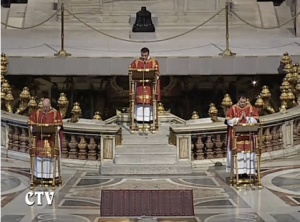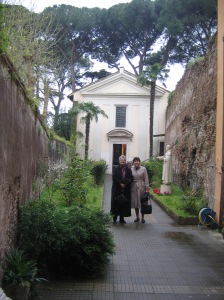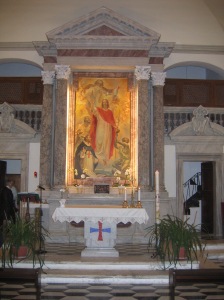Home » Posts tagged 'Paschal Triduum'
Tag Archives: Paschal Triduum
Holy Week in Rome 2016
Holy Week in Rome: There are so many opportunities in Rome during Holy Week, I have highlighted just a few in Italian and English, including the normal Roman Rite, and a few exemplars from the “Extraordinary Form”, Byzantine Rite, and Anglican rites. All of the Station Churches and Papal Liturgies are noted.
I would welcome input from anyone who is aware of others of particular interest, especially where good liturgy can be found – including good music, good preaching, good aesthetic, etc.
Palm Sunday of the Lord’s Passion
- Station Church: San Giovanni in Laterano – 0700 (English); 1730 (Italian)
- Papal Liturgy: Piazza San Pietro – 0930
Monday
- Station Church: Santa Prassede all’Esquilino – 0700 (English); 1800 (Italian)
- Byzantine Vespers of the Presanctified Gifts – Russicum/Sant’Antonio Abate – 1800
Tuesday
- Station Church: Santa Prisca all Aventino – 0700 (English); 1800 (Italian)
- Anglican Centre 50th Anniversary Eucharist/Chrism Mass – 1245 (English)
- Byzantine Vespers of the Presanctified Gifts – Russicum/Sant’Antonio Abate – 1800
- Evening Prayer with Sant’Egidio Community – Santa Maria in Trastevere 20:30
Wednesday
- Station Church: Santa Maria Maggiore – 0700 (English); 1730 (Italian)
- Seven Churches Pilgrimage of St. Filippo Neri (a devotional tradition since 1559)
- Join the seminarians of the Pontifical North American College in a tour of the Seven Churches, starting with the morning station mass at Santa Maria Maggiore. It is about 22km walking total and will take all day. Pack a lunch or plan to stop along the route:
- Santa Maria Maggiore
- San Lorenzo Fuori le Mura
- Santa Croce in Gerusalemme
- San Giovanni in Laterano
- San Sebastiano
- San Paolo fuori le Mura
- San Pietro al Vaticano
- Join the seminarians of the Pontifical North American College in a tour of the Seven Churches, starting with the morning station mass at Santa Maria Maggiore. It is about 22km walking total and will take all day. Pack a lunch or plan to stop along the route:
- Byzantine Vespers of the Presanctified Gifts – Russicum/Sant’Antonio Abate – 1800
- Office of Tenebrae
- Paul’s Within the Walls (Episcopalian) – 1830 (English)
- Santissima Trinita’ dei Pellegrini (extraordinary form) – 2030 (Latin)
Holy Thursday
- Papal Liturgy: Chrism Mass – Basilica San Pietro – 0930
- Mass of the Lord’s Supper (Beginning of the Paschal Triduum Liturgy)
- San Giovanni in Laterano – 1730 (Italian) – Station Church
- Santa Maria in Trastevere – 1730 (Italian)
- Oratory of San Francesco Saverio al Caravita – 1800 (English)
- Altars of Repose pilgrimage – Roman devotional tradition is to walk around the city after the liturgy ends for the evening, visiting the beautifully decorated altars of repose in (at least seven) different churches.
Good Friday
Solemn Liturgy of the Lord’s Passion with Veneration of the Cross:
- Station Church: Basilica Santa Croce in Gerusaleme – 1500 (Italian)
- Oratory of San Francesco Saverio al Caravita – 1500 (English)
- Papal Liturgy: Basilica San Pietro – 1700 (Italian)
- Santissima Trinita’ dei Monti – 1800 (French)
Stations of the Cross devotion, with Pope Francis at the Colosseum, 2115
Holy Saturday
The Great Vigil of Easter
- Oratory of San Francesco Saverio del Caravita – 2000 (English)
- Papal Liturgy: Basilica San Pietro – 2030 (Italian)
- Station Church: San Giovanni in Laterano – 2100 (Italian)
- Venerable English College – 2130 (English)
Easter Sunday
Mass of the Lord’s Resurrection
- Byzantine Divine Liturgy – Russicum/Sant’Antonio Abate – Midnight
- Papal Liturgy: Piazza San Pietro – 1000 (Italian)
- Oratory of San Francesco Saverio del Caravita – 1100 (English)
- Station Church: Santa Maria Maggiore – 1800 (Italian)
Pope Francis Urbi et Orbi Blessing – Piazza San Pietro – 1200 (Multilingual)
Solemn Vespers (concluding the Paschal Triduum)
- Chiesa di Sant’Anselmo al Aventino – 1700 (Italian)
- Byzantine – Russicum/Sant’Antonio Abate – 1800
Easter Week Station Churches (Italian):
- Monday – San Pietro – 1700
- Tuesday – San Paolo fuori le Mura – 1730
- Wednesday – San Lorenzo fuori le Mura – 1800
- Thursday – XII Apostoli al Foro Traiano – 1830
- Friday – Santa Maria ad Martyres (Pantheon) – 1700
- Saturday – San Giovanni in Laterano – 1630
- Divine Mercy Sunday – San Pancrazio – 1600
- Conclusion of the Station Churches pilgrimage
Holy Thursday in Rome
The Paschal Triduum in Rome this year sees even more than its usual number of pilgrims and visitors. In part this is because of the lateness of the season – in two centuries, it will be this late or later only thrice – and in part because of early arrivals for the beatification of John Paul II next Sunday, May 1.
Given a shortage of tickets to papal events, a group of friends – from the Lay Centre, students in Rome and visitors from the States – opted for the neighboring parish basilica of Santa Maria in Domnica, alias the Navicella, for the Mass of the Lord’s Supper after an early dinner.
Our local parish, animated by the Communione e Liberazione movement, the church is beautifully mosaiced, based on an ancient site, and normal Sunday liturgy includes a full choir of young voices, so our expectations were a little high. We did want something shorter than the papal liturgy down the street at the Cathedral, but none of us were quite prepared for what felt more like a daily mass with a couple extra bits added on – the entire liturgy, including a period of adoration at the altar of repose, was finished in 55 minutes.
There was no choir, no psalmist – even the Gloria was merely recited. The washing of the feet (of a dozen teen and preteen boys) barely took five minutes. The only minister of the mass was the presiding priest – even for the procession to the altar of repose the thurifer and crucifer were pulled form the assembly and dressed in ‘civvies’, rather than an alb (or cassock and surplice).
On one hand, there is something nice about not having to wait for three hours to get into a three hour liturgy. On the other hand, the liturgy looses something when, as one visitor said, it seems as if the presider has more important things to do afterwards!
Still, the altar of repose was tastefully prepared, with a simple and elegant wooden tabernacle. The abbreviated liturgy left us four hours to visit and pray at as many churches as desired before midnight; the goal was the traditional seven, culminating at the Pantheon, which was reputed to have one of the most beautiful altars prepared in the city.
(Some friends just reported on their evening at Trinità dei Monti at the top of the Spanish Steps, as one of the most beautiful liturgies ever experienced – something to keep in mind next year!)
Pictures pending – but here’s a schedule of our mini-pilgrimage:
+ Santa Maria in Cosmedin – closed
+ San Giorgio in Valabro – closed
+ San Nicola in Carcere – open
+ Santa Maria in Campitelli – open
+ Santa Maria in Ara Coeli – open
+ San Marco – closed
+ Cappella della Madonnella – open
+ Chiesa del Gesù – closed
+ Santa Maria Sopra Minerva – open
+ Sant’Ignazio – closed
+ Santa Maria ad Martyres (Pantheon) – closed
+ San Luigi dei Francese – open
+ Sant’Agnese in Agone – closed
+ Sant’Andrea della Valle – open
The intended grand finale of the Pantheon was closed, as was the Jesuit headquarters of the Gesù!
The French national church of San Luigi probably was the most evocative – you enter a completely dark church, only a small light in a distant chapel visible. As you stumble your way to its source, you see a single light illuminating a simple altar reserving the Blessed Sacrament under both species, tucked into the Contarelli Chapel, famous as each of sides is adorned with masterpieces of Caravaggio: the Calling of St. Matthew, the Inspiration of St. Matthew, and the Martyrdom of St. Matthew. With an entire church in black, and this small corner in light, it was as if Caravaggio himself had planned the entire experience.
San Nicola’s altar of repose was surrounded by about fifty candles, and attended by a solitary monk. Santa Maria in Compitelli was a church I had never visited before, and beheld there an 11th century icon and one of the rare baroque altars that actually looks good. Santa Maria in Ara Coeli had candles along the stairs leading up the Capitoline hill to the entrance and an altar of repose filled with flowers. Madonella is almost Reformed in its whitewashed and modern simplicity, and Sopra Minerva offered no surprises. At Sant’Andrea some very modern, interpretive paintings of the Stations of the Cross almost distracted before one could get to the altar of repose, but offered a welcome end to our evening’s sojourn in any case.
Paschal Triduum 2010
The first time I participated in the Easter Triduum was also my altar serving debut. I was in third grade, nine years old. My training was held right after school by Sr. Mary Thorne, if I recollect correctly, and a few hours later I was serving my first mass, on Holy Thursday. That was twenty-three years ago and I have never intentionally missed any part of the Triduum.
In fact, I can only remember missing the whole thing once, because I was sick – but I had already done all the planning and training for the liturgies, and had very reliable volunteer lay liturgical ministers to rely upon in absentia. One other year, I was in the ER during the Easter vigil with a friend. Other than these two, I have worshipped during the high holy days, and usually as a server, lector, or liturgist and master of ceremonies. Even in my last interim parish ministry, where I was not the primary liturgist, I still had a contingent of catechumens to bring through the rites.
That said, it is kind of nice (but also a bit weird) to be absolutely and completely free of responsibility throughout the Triduum, and to be in Rome. There are three places where every Catholic should spend Holy Week at least once, in my opinion: Jerusalem, Rome, and Notre Dame. Though not necessarily in that order.
Throughout my four years at Notre Dame, I was an altar server in the Basilica of the Sacred Heart, and sometime assistant MC there and sacristan/liturgy coordinator at the Chapel of Our Lady of Guadalupe in Keough Hall. Triduum was always a great deal of work, but always masterfully done, accompanied by beautiful music, and in the words of one visiting curial cardinal (who so enjoyed Holy Week at ND he came back twice while I was there), “This is better than Saint Peter’s!”.
I am inclined to agree, but with qualification. To be clear, I am disappointed in nothing of the Triduum here in Rome, except for the mob (the Romans’ answer to the queue, or line).
This is, after all, the first church (not in chronology, but in order). The Mass of the Lord’s Supper on Holy Thursday was celebrated at the Pope’s Cathedral, the Archbasilica of Saint John Lateran, Mother-Church of Rome. The Service of Our Lord’s Passion on Good Friday and the Great Vigil of Easter were celebrated at the Vatican Basilica of Saint Peter. All were presided by the Bishop of Rome, Benedict XVI, and he was homilist at the first and last (Raniero Cantalamesa, OFM Cap., the preacher of the papal household, had the homily on Good Friday, as you may have heard.) I prayed the Way of the Cross from the edge of our property, a bluff overlooking the Coliseum with clear line-of-sight of the Holy Father about 300 meters away.
The prayer guides are published pocket-sized booklets, illustrated with prints of 15th and 16th century frescoes from Italian churches. The liturgy was celebrated in Latin, the mass parts chanted in Gregorian style, and deacons blessed with angelic voices chanted the gospel – on Thursday it was proclaimed twice, once each in both Latin and Greek! (Presumably in honor of the fact that this year, Passover and Easter on both the Julian and Gregorian calendars all coincide). The prayers of the faithful throughout the three-day liturgy were offered in French, Spanish, English, Polish, German, Portuguese, Russian, Tagalog, Swahili and Arabic. Readings were in Italian, Greek, Latin, French, English, German, and Spanish.
The exultet in Latin is amazing. The Passion on Good Friday in slowly chanted Latin is impressive, but also a little hard on the back. (OK, yes, the very act of complaining about listening to the passion, when it is after all, the passion, is a sin I will publicly confess here and now: Mea culpa, ego sum mereum humanum.)
I found this interesting, though: Over the last few years in liturgical circles we have been encouraged to discourage the reading of the Passion in parts, as it is often printed in the missalletes and music books, and instead just have three deacons or readers proclaim the reading in turn. At the papal liturgy at San Pietro, with the ‘new’ Marini in charge, they had each deacon proclaim different parts (Narrator, Jesus, Peter/others) and the choir as the crowd/assembly.
This touches on one of the great reasons to be in Rome: The liturgical diversity. I do not just mean the fact that there are representatives of all the major rites of the Church here in the city (Alexandrian, Antiochene, Armenian, Byzantine, Chaldean, and Latin), but also that within the Latin rites, within the Roman rite specifically, you have diversity. Just between the Roman Cathedral (San Giovanni) and the Vatican Basilica (San Pietro), with the same pope presiding and the same papal MC, you find different ways of celebrating and different customs.
One small example, during the Eucharistic prayer: At San Giovanni, we do not kneel, and there is no bell during the epiclesis and the two elevations, but there is incense. At San Pietro, we kneel from the epiclesis to the mystery of faith, and there is a bell for the epiclesis and two elevations, but no incense.
Another interesting note, if a little random. While the Mass of the Lord’s Supper traditionally commemorates the institution of the Eucharist in the form of the Last Supper, it has traditionally been called the institution of the priesthood, through the act of the washing of feet. Historically, of course, and theologically, this is not entirely accurate so back home we had long since opted away from this simplistic phrasing lest it require a great deal of explanation. However, in the pre-liturgy announcements at San Giovanni, there it was “The Institution of the Eucharist and of the ministerial priesthood”.
Twelve presbyters were the mandatum at the Holy Thursday Mass of the Lord’s Supper, whose feet the Holy Father washed, though none of this was visible to me. The diplomatic corps were invited to communion with the Holy Father as minister, which they recieveed kneeling and on the tongue, or, they recieved a blessing instead of communion, if appropriate; but everyone else recieved communion along the aisles (standing, and in tongue or hand as the communicant prefered).
After returning to the Lay Centre for dinner, a group of us spent the evening in an adoration pilgrimage of seven churches during the traditional period until midnight: Basilica San Giovanni e Paolo, Basilica Santa Maria in Domnica, the Baptistry of San Giovanni, Archbasilica San Giovanni, Basilica Sant’Antonio di Padova, Basilica Santi Quattri Coronatti, and the Chapel of the Holy Trinity.
St. Peter’s has a capacity of over 60,000 roughly the same as Notre Dame Stadium before the 1997 expansion. That plus room for another 400,000 in the piazza makes for a somewhat larger assembly than the 2500 or so who can fill the Basilica of Sacred Heart at Notre Dame. For an experience of the Church universal in the heart of the Church, you cannot beat Rome. But for that Church universal manifest in a local church, I do not think even Rome can beat Notre Dame. To a degree, its like apples and oranges. The assembly is different, and the considerations are different. One aims for a liturgy that represents the whole church, which is probably represented pretty well by those present. The other aims for a liturgy of the local church being wholly church in its place. For Latin and the biggest of big liturgy, it is Rome. For best liturgy captured in a particular church, music that is beautiful, reverent and accessible, it is Notre Dame. I am happy to have had my four years at ND, and hope to get a few more here in Rome!
For Easter Sunday, between the full papal Triduum experience and the rain, I decided to go to the little church served by the Trinitarian Fathers, Chiesa San Tomasso in Formis (St. Thomas in Chains), literally just outside our front gate and around the corner. About 30 people filled the church, including two priests and two other Lay Centre folk, director Donna Orsuto and visiting scholar Dr. Aurelie Hagstrom, chair of the theology department at Providence College in Rhode Island who is here for a month of Marian research. Such a different experience after the big liturgies to be in a small community! The only space for the after-mass social was the tiny sacristy behind the altar, as long as we entered from one side and exited the other!
After a quick cappuccino and cornetto to celebrate the end of Lenten fasting, we watched the Urbi et Orbi on TV and prepared for a mid-afternoon Easter feast. Only a couple guests joined us, making us about fifteen in all – a perfect way to spend a drizzly Easter afternoon.









